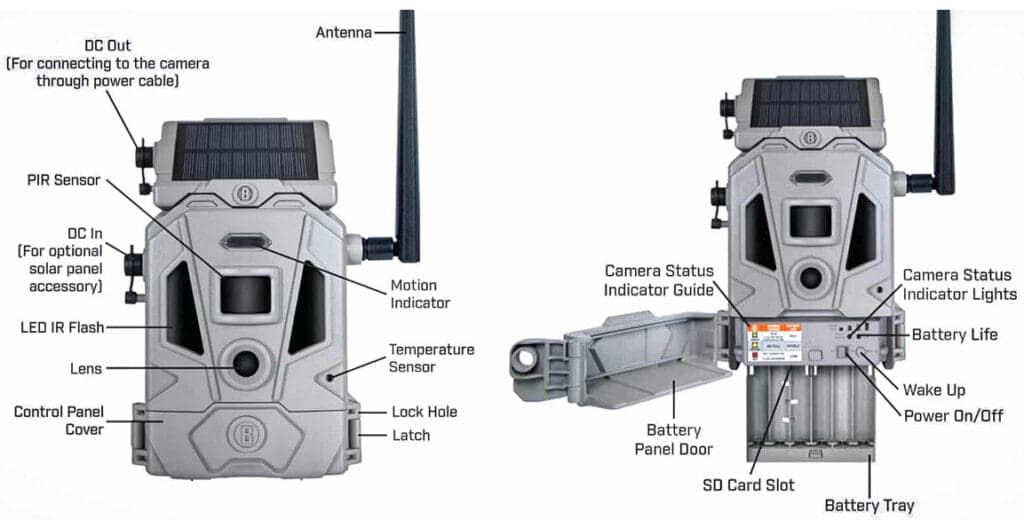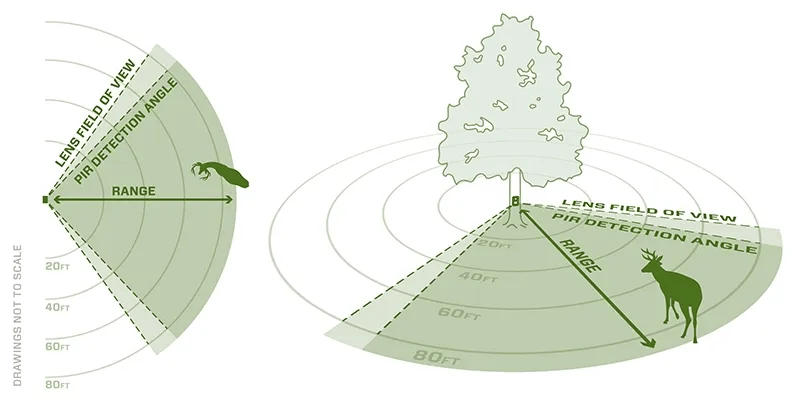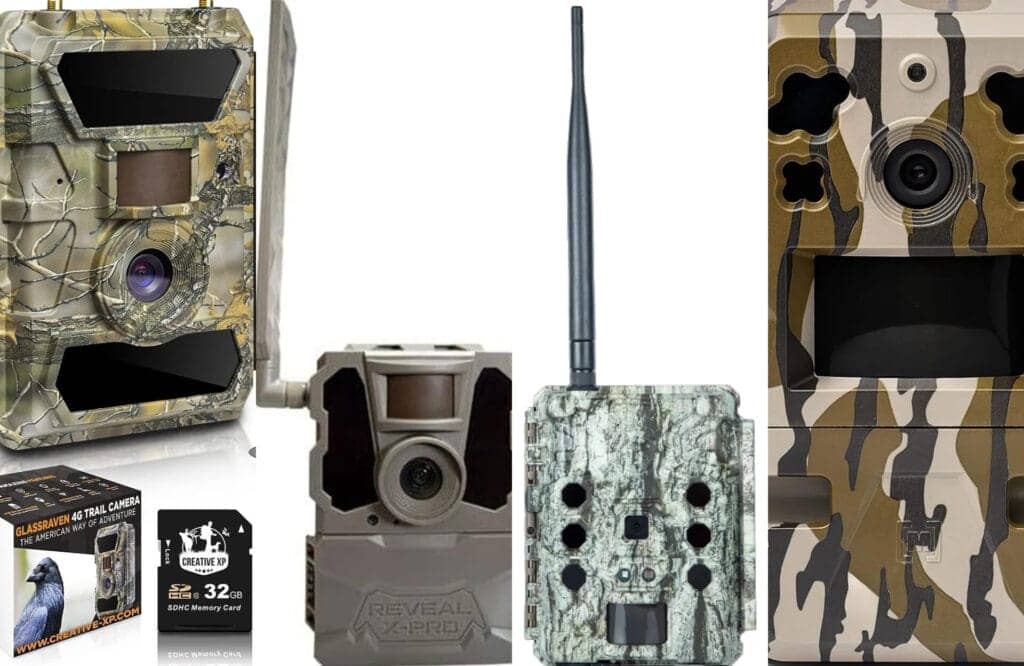Last updated on December 2nd, 2023 at 05:29 pm
Ultimate Guide to Understand How Does Game Camera Work: Technology, Uses, and Tips
Have you ever wondered how does game camera work? These fascinating devices, also known as trail or wildlife cameras, are revolutionizing the way we interact with the natural world. Here’s a peek into their world:
- Capturing Nature’s Candid Moments: Game cameras are ingeniously designed to record wildlife activities without human presence. They employ motion sensors as well as PIR sensors to trigger the camera, snapping pictures or videos of wildlife in their natural habitat.
- Technological Marvels: From the basic models with essential features to the advanced ones with cellular connectivity, these hunting cameras are a blend of innovation and practicality.
- Growing Popularity:
- Wildlife Enthusiasts: Nature lovers are increasingly using these cameras to study animal behaviors and patterns.
- Hunters: Game cameras have become crucial in scouting and tracking animal movements for hunting.
- Property Owners: Homeowners are beginning to use trail cameras for security, watching over their properties with an unobtrusive eye.
Each game camera comes packed with a variety of features. Some offer night vision capabilities, while others boast long battery lives or high-resolution imaging. The diversity in the trail camera’s functionalities makes them a tool suitable for multiple purposes.
Game cameras have transcended their initial use in wildlife observation. Today, they serve a broader audience, fulfilling roles in outdoor security, hunting, and even scientific research. Let’s dive deeper into this captivating world of game cameras and discover what makes them tick!
Types of Game Cameras

In the realm of game cameras, you’ll encounter three distinct types: traditional, cellular, and WiFi trail cameras. Each boasts unique features tailored to various user needs.
Traditional Trail Cameras: The Old-School Approach
- Snapshot Savvy: These cameras activate when their motion sensors detect movement, saving the captures to an SD card.
- Power Prowess: Expect long battery life, often a full year, with AA or AAA batteries.
- Manual Retrieval: You’ll have to physically collect the SD card to see the images or videos.
- Affordability: Prices are more accessible, generally between $20 and $70.
- Ideal Use: Best for nearby areas or if you prefer a hands-on approach.
Cellular Trail Cameras: The Connected Choice
- Instant Updates: These cameras send images directly to your phone or laptop via cellular networks.
- Network Necessity: They require a subscription plan, similar to a cell phone.
- Dual Storage: Images are stored on an SD card and in the cloud for easy access.
- Price Point: Slightly higher, ranging from $40 to $300.
- Best for Remote Monitoring: Perfect for distant locations or when immediate alerts are needed.
WiFi Trail Cameras: The Flexible Middle-Ground
- Wireless Convenience: These cameras use a WiFi signal to transmit images to a connected device.
- No Subscription Required: Unlike cellular models, they don’t need a monthly plan, making them cost-effective.
- Proximity Matters: Effective within the range of your WiFi network, ideal for property surveillance.
- Flexible Access: Offers the convenience of remote access without the extra cost of cellular models.
Each type of game camera offers a unique blend of features and conveniences.
Traditional models are budget-friendly and straightforward, while cellular cameras provide real-time updates and greater coverage. WiFi cameras strike a balance, offering remote access without the need for a cellular subscription.
Your choice hinges on your specific needs, whether it’s for casual wildlife observation, serious hunting, or home security.
Key Game Camera Features and Components

Game cameras come equipped with a suite of key features and components that make them indispensable for wildlife observation and property surveillance.
| Feature | Explanation |
|---|---|
| Motion Sensors and Trigger Speed | Motion sensors detect movement and heat, triggering the camera to capture images quickly. Trigger speed, the time taken to snap a photo after detecting motion, is crucial for capturing fleeting wildlife moments. |
| Battery Life and Power Sources | Game cameras are powered by batteries (often AA or AAA), with some offering rechargeable options. Long battery life is essential for extended field use without frequent replacements. |
| Storage Options | Images and videos are stored either on SD cards for easy retrieval or in cloud storage for remote access, offering flexibility in data management. |
| Night Vision Technologies | These technologies, including incandescent flash, infrared, and advanced night vision, enable the camera to capture clear images in low light conditions, essential for nocturnal wildlife monitoring. |
These features collectively make game cameras a robust tool for capturing the elusive moments of nature and ensuring security around properties.
How Do Game Cameras Work?
Let’s imagine a deer passing by a game camera. Here’s how the camera would work, step by step:

| Step | Key Feature | Role in Capturing the Deer |
|---|---|---|
| 1. Detection | Motion Sensors | Detects the deer’s movement and heat as it enters the camera’s range. *When an animal or subject enters the camera’s range, typically 50 to 100 feet, the motion sensors detect the movement and heat. These sensors are calibrated to detect even subtle movements, ensuring that the deer does not pass unnoticed. |
| 2. Triggering | Trigger Speed | Quickly activates the camera to capture the image or video as soon as the deer is detected. *This is the time it takes for the camera to react to the detected motion and take a photo or start recording. The faster the trigger speed (some as quick as 0.14 seconds), the more likely the camera will capture a clear image of the moving subject. |
| 3. Capturing | Day/Night Technology | Captures a clear image during the day or utilizes night vision technology (like infrared) to capture a detailed image at night without startling the deer. *Nighttime Capture: As light fades, night vision technologies take over. Infrared cameras emit a faint or no glow, capturing images without startling wildlife. Incandescent flash provides brighter, color images but may be more intrusive. Some advanced cameras use night vision technology to convert photons into clear images, even in low light. |
| 4. Storing | Storage Options | Saves the captured image or video on an SD card or uploads to cloud storage for remote access (in cellular models) *Storing on SD / Memory Card: Most game cameras store the captured images or videos on an internal SD card, which can later be removed for data retrieval. Cloud Storage Option: In more advanced models, especially cellular game cameras, the captures can be uploaded to cloud storage. This allows for remote access to the images and videos, often viewable on a smartphone or computer. |
| 5. Power Management | Battery Life | Ensures the camera remains operational for extended periods, capturing events like the deer’s passage efficiently. *Long-Lasting Operation: Throughout this process, the camera relies on its power source – typically AA or AAA batteries. The longevity of these batteries is crucial, as game cameras are often placed in remote locations. Some models can run up to a year on a single set of batteries, depending on their usage and settings. |
What are the Uses and Applications of Game Cameras?
1) Wildlife Management and Research
- Studying Wildlife: Game cameras are crucial in wildlife management and research. They provide insights into animal behavior, nesting patterns, and population dynamics.
- Data Collection: These cameras help in collecting demographic data like buck-doe and fawn-doe ratios, essential for understanding and managing wildlife populations.
2) Hunting
- Scouting Made Easy: For hunters, game cameras are a game-changer. They allow scouting multiple areas simultaneously, giving a clear picture of game animal movements and habits.
- Quality and Abundance Tracking: Hunters use these cameras to monitor 24-hour activity and survey the quality and abundance of game animals on their property.
3) Nature Viewing
- Unobtrusive Observation: Nature enthusiasts love game cameras for their ability to document and view shy or rarely seen wildlife. This allows for appreciation and observation without disturbing the natural activities of wildlife.
4) Property Surveillance and Security
- Vigilant Security: Cellular trail cameras are increasingly used for security purposes. They alert property owners to the presence of intruders or predators, ensuring peace of mind.
5) Documentation of Wildlife Diversity
- Cumulative Wildlife Records: Game cameras help landowners and managers document the diversity of wildlife species on their property. This information is valuable for enhancing wildlife sections of property management plans.
6) Monitoring Animal Behavior
- Behavioral Insights: These cameras are instrumental in documenting animal behaviors, such as predator activities around nesting birds. They offer a non-intrusive method to monitor animals in their natural habitat.
7) Additional Uses
- Versatile and Multi-purpose: Game cameras find applications beyond wildlife-related activities. They are used in sports photography, especially in capturing wildlife sports events, and for monitoring campsites.
Game cameras serve a wide array of purposes from wildlife management, research, hunting, and nature viewing, to property security and documenting wildlife diversity.
Their ability to capture detailed images and track wildlife movements with minimal disruption makes them invaluable tools in both natural and human-dominated landscapes.
Also Read > Expert Analysis: Game Camera vs Security Camera Pros and Cons
How to Choose the Right Game Camera For Your Needs?

Ok, now you got how it works. But how do you find the right trail camera for your needs? Here are the factors to consider:
Purpose: First, determine what you’ll primarily use the camera for. Is it for wildlife management, hunting, nature viewing, or security? Your purpose will guide many of the features you need.
Type: Non-Cellular vs. Cellular
Non-Cellular: Traditional and generally more affordable. Ideal for hands-on management and where immediate data transmission isn’t critical.
Cellular: Offers convenient features like sending images directly to your smartphone. Perfect for remote monitoring or when frequent site visits are impractical.
Image Quality
Megapixels (MP): Opt for a camera with a 12 to 16 MP rating, ideal for balancing quality and file size. Higher megapixels benefit detailed wildlife photography but might be overkill for general surveillance or scouting.
Trigger Speed
Responsiveness: A faster trigger speed is essential for capturing fast-moving wildlife, with some cameras boasting speeds as quick as a fraction of a second.
Battery Life
Duration: Especially important if you’re leaving the camera in the field for extended periods. Longer battery life means fewer trips to change batteries.
Infrared vs. Flash
Infrared Cameras: Emit a faint red glow, less intrusive for wildlife and suitable for general use.
Flash Cameras: Emit a bright light, providing clearer, color images at night but potentially startling animals.
Basic Functions
Customization: Most cameras offer both video and picture options, with adjustable settings for megapixels and video resolution to suit your specific needs.
Accessories
Enhancements: Consider additional accessories like security boxes, mounting brackets, or solar panels to prolong battery life and protect the camera from theft or damage.
Considering these factors, you can choose a game camera that perfectly aligns with your needs, whether for capturing the elusive wildlife, monitoring your property, or any other purpose you have in mind.
Wrapping Up
As we wrap up our exploration of how game cameras work, their various types, and key features, remember that these devices are more than just tools for capturing wildlife or enhancing home security. They are windows into the natural world, offering insights and connections that were once beyond our reach. Whether you’re a seasoned hunter, a wildlife enthusiast, or someone looking to bolster your property’s security, a trail camera can significantly enrich your experience.
For those of you seeking the latest advancements in game camera technology, particularly those with live feed capabilities to your phone, be sure to check our blog on “Best Game Camera with Live Feed to Phone: 10 Picks for 2023!”. This guide will provide you with top recommendations, ensuring you stay connected to your outdoor interests wherever you are.
Before you go, ponder this: If you could place a trail camera anywhere in the world, where would it be, and what wildlife or scene are you hoping to capture? Imagine the possibilities and the unseen moments you could witness. Trail cameras are not just devices; they’re your eyes in the heart of nature, capturing moments that would otherwise go unseen.
FAQ Section
Q1: How does a trail camera work?
A1: A trail camera captures photos or videos when its motion sensor detects movement within its field of view.
Q2: What is the difference between a trail camera and a game camera?
A2: A trail camera and a game camera are essentially the same, both used for wildlife monitoring and hunting.
Q3: Can a cellular trail camera work without a wireless network?
A3: Cellular trail cameras require a cellular network to transmit photos and videos but can store captures on an SD card without it.
Q4: What features make a trail cam suitable for home security?
A4: Trail cams are great for home security due to their motion sensors, night vision capabilities, and remote monitoring features.
Q5: How far can a wildlife camera detect movement?
A5: Wildlife cameras typically detect movement within a range of 50 to 100 feet, depending on the model.
Q6: Does a wifi trail camera offer better connectivity than a standard model?
A6: A wifi trail camera offers convenient connectivity for remote access, although its range is limited to the wifi network’s coverage.
Q7: What should I look for when choosing a trail camera for hunting?
A7: For hunting, look for a trail camera with a fast trigger speed, high image quality, and reliable night vision.
Q8: How do trail cams manage power in the field?
A8: Trail cams manage power efficiently, often running on AA or AAA batteries, with some models supporting solar panels.
Q9: Can I use a trail camera to observe animals without disturbing them?
A9: Yes, trail cameras are perfect for observing animals without disturbance, thanks to their motion sensors and discreet operation.
Q10: Do trail cameras require frequent maintenance?
A10: Trail cameras require minimal maintenance, with long battery life and large storage capacity reducing the need for frequent checks.
Related Posts
Rohan, the founder and driving force behind Trail Cam Rookies, first discovered his passion for trail cameras during an expedition in Central Europe. Fascinated by how these devices bridge the gap between humans and wildlife, he has since dedicated himself to exploring and sharing the intricacies of trail camera technology. Through Trail Cam Rookies, he offers beginner-friendly guides, comprehensive product reviews, and practical tips to help enthusiasts connect more deeply with the natural world.


